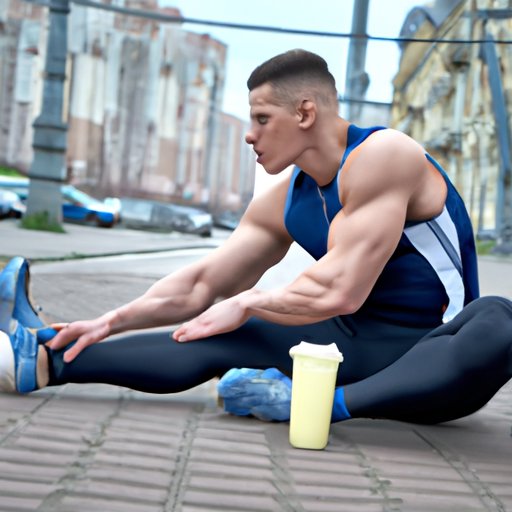
I. Introduction
Have you ever had a hard workout and woke up the next day feeling like you got hit by a bus? Muscle soreness, or DOMS (Delayed Onset Muscle Soreness), is a common occurrence after intense physical activity. While it might be a sign of hard work, it can also hinder your ability to work out in the coming days. This article will explore different approaches to alleviate muscle soreness and how to prevent it before it starts so you can keep making progress towards your fitness goals.
II. 5 Simple Stretches to Relieve Muscle Soreness
Stretching is an essential component of any workout routine, and it becomes even more important after an intense workout. Not only does it help alleviate soreness, but it also helps improve flexibility and range of motion. Here are five simple stretches you can do anywhere:
- Quad Stretch
- Hamstring Stretch
- Butterfly Stretch
- Cobra Stretch
- Child’s Pose
Incorporating these stretches into your routine can make a significant difference in how you feel after a workout.
III. The Science Behind Muscle Soreness: How to Recover Faster
Understanding the science behind muscle soreness can help you manage it more effectively. Delayed onset muscle soreness or DOMS typically shows up 24-48 hours after a workout. It’s the result of microscopic damage to the muscle fibers, usually due to resistance training or high-impact activities. In addition to stretching, there are other ways to alleviate soreness:
- Foam rolling
- Massage
- Ice baths or cold showers
Each of these remedies can help reduce inflammation and shorten recovery time. It’s essential to make sure you’re using the correct technique to get the most benefit from these recovery methods.
IV. Eating for Muscle Recovery: Foods that Reduce Soreness
Fuel your body with the right nutrients to enhance muscle recovery and reduce soreness. Here are some foods that can aid in muscle recovery:
- Protein-rich foods like chicken, fish, eggs, and Greek yogurt
- Omega-3 fatty acid-rich foods such as salmon, walnuts, and chia seeds
- Carbohydrates like sweet potatoes, whole grains, and fruit to replenish glycogen stores
- Anti-inflammatory foods like dark leafy greens, berries, and spices
- Hydration with water and electrolytes like coconut water.
Incorporating these foods into your diet, along with proper hydration, can help reduce soreness and enhance muscle recovery.
V. The Importance of Active Recovery: How to Keep Your Muscles Moving
Active recovery refers to engaging in low-intensity activities that promote circulation, flexibility, and relaxation. Here are some examples of activities that qualify as active recovery:
- Walking
- Yoga
- Swimming
- Static Stretching
- Foam Rolling
Incorporating active recovery into your workout routine can help reduce soreness and improve overall performance.
VI. Muscle Soreness 101: How to Prevent It Before It Starts
The best way to manage muscle soreness is to prevent it before it starts. Here are some strategies that can help:
- Gradually increase workout intensity
- Proper form with exercises
- Hydration before, during, and after workouts
- Proper warm-up and cool-down
- Get sufficient rest and recovery time between workouts
Implementing these strategies can help prevent soreness and minimize the risk of injury.
VII. Conclusion
Managing muscle soreness is an essential component of any fitness routine. Incorporating stretching, recovery methods, proper nutrition, active recovery, and preventive strategies can help reduce soreness and improve overall performance. Taking care of your muscles will ensure that you can continue to reach your fitness goals and maintain a healthy lifestyle.
Remember, soreness is normal, but it doesn’t have to stay for days on end.




